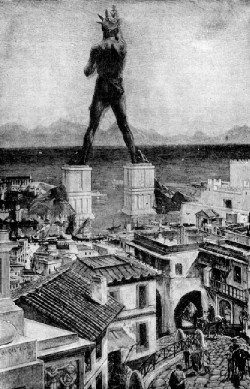The Colossus Of Rhodes was a statue of the
Greek God Helios, erected in the city of Rhodes on the Greek island of
Rhodes by Chares of Lindos between 292 and 280 BCE. The Colossus was
constructed to celebrate Rhodes’ victory over the ruler of Cyprus,
Antigonus I Monophthalmus, who unsuccessfully besieged Rhodes in 305
BCE. The great ediface stood over 30 metres(107 ft) in height which
makes it one of the tallest statues of the ancient world

Modern engineers have put forward a plausible hypothesis for the
statue construction, based on the technology of those days and the
accounts of Philo and Pliny who both saw and were able to describe the
remains. The base pedestal was at least 18 metres(60 ft) in diameter and
either circular or octagonal. The feet were carved into stone and
covered with thin bronze plates riveted together. Eight forced iron bars
set in a radiating horizontal position formed the ankles and turned up
to follow the lines of the legs while becoming progressively smaller.
Individually cast curved bronze plates 1500mm(60 inches) square with
turned in edges were joined together by rivets through holes formed
during casting to form a series of rings. The lower plates were 25mm(1
inch) in thickness to the knee and 3/4 inch thick from knee to abdomen,
while the upper plates were 1/4 to 1/2 inch thick except where
additional strength was required at joints such as the shoulder, neck,
etc. The legs would need to be filled at least to the knees with stones
for stabilty. Accounts described earthen mounds used to aid
construction; however, to reach the top of the statue would have
required a mound 91 metres(300 ft) in diameter, which exceeded the
available land area, so modern engineers have proposed that the
abandoned siege towers stripped down would have made efficient
scaffolding.
The Colossus of Rhodes stood for only 56 years until Rhodes was hit by the 226 BCE Rhodes Earthquake, when significant damage was also done to large portions of the city including the harbour and commercial buildings, which were destroyed. The statue snapped at the knees and fell over on to the land. Ptolemy III offered to pay for the reconstruction of the statue, but the oracle of Delphi made the Rhodians afraid that they had offended Helios, and they declined to rebuild it. The remains lay on the ground as described by Strabo for over 800 years, and even broken, they were so impressive that many traveled to see them. Pliny the Elder remarked that few people could wrap their arms around the fallen thumb and that each of its fingers was larger than most statues.
Media reports in 1989 initially suggested that large stones found on the seabed off the coast of Rhodes might have been the remains of the Colossus; however this theory was later shown to be without merit. Another theory published in an article in 2008 by Ursula Vedder suggests that the Colossus was never in the port, but rather on a hill named Monte Smith, which overlooks the port area. The temple on top of Monte Smith has traditionally thought to have been devoted to Apollo, but according to Vedder, it would have been a Helios sanctuary. The enormous stone foundations at the temple site, the function of which is not definitively known by modern scholars, are proposed by Vedder to have been the supporting platform of the Colossus
The Colossus of Rhodes stood for only 56 years until Rhodes was hit by the 226 BCE Rhodes Earthquake, when significant damage was also done to large portions of the city including the harbour and commercial buildings, which were destroyed. The statue snapped at the knees and fell over on to the land. Ptolemy III offered to pay for the reconstruction of the statue, but the oracle of Delphi made the Rhodians afraid that they had offended Helios, and they declined to rebuild it. The remains lay on the ground as described by Strabo for over 800 years, and even broken, they were so impressive that many traveled to see them. Pliny the Elder remarked that few people could wrap their arms around the fallen thumb and that each of its fingers was larger than most statues.
Media reports in 1989 initially suggested that large stones found on the seabed off the coast of Rhodes might have been the remains of the Colossus; however this theory was later shown to be without merit. Another theory published in an article in 2008 by Ursula Vedder suggests that the Colossus was never in the port, but rather on a hill named Monte Smith, which overlooks the port area. The temple on top of Monte Smith has traditionally thought to have been devoted to Apollo, but according to Vedder, it would have been a Helios sanctuary. The enormous stone foundations at the temple site, the function of which is not definitively known by modern scholars, are proposed by Vedder to have been the supporting platform of the Colossus

خارج الموضوع تحويل الاكوادإخفاء الابتساماتإخفاء